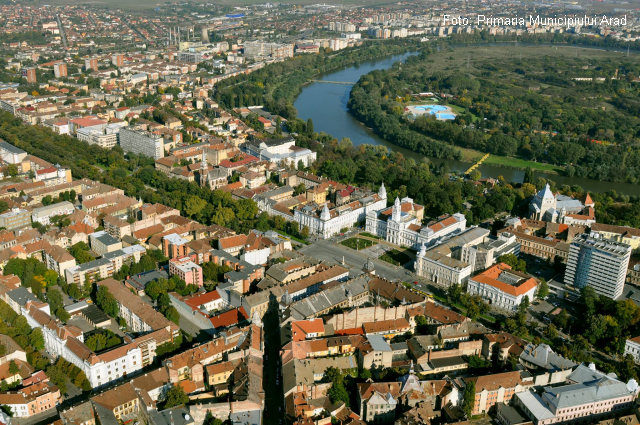In Arad County

Daniel Onea, 17.12.2020, 23:29
Todays stopover is in the west of Romania. We have been many times to the seat of the county, the city of the same name, with its rich heritage in culture and history, so we will head out to some of the landmarks in the county.
Our guide is Casiana Alexandra Radut, a tourism adviser with the National Center for Tourist Information and Promotion. She told us a few things about the very interesting history of the city of Arad:
“We dubbed it the City of Palaces, for obvious reasons. At the same time, we have a very rich Secession heritage, with over 40 protected buildings. I would like to mention a few of them, which we present as part of our tours: the Neuman Palace, the Administration Palace, the Palace of Culture, and Földes Palace, which is also the first Secession building in Arad, then Bohus Palace, and Szantay Palace. Of these, Földes Palace is emblematic for Arad. It was designed by architect Emil Tabacovici, who had an important contribution to building Novi Sad in the latter part of his life. It is a palace dedicated to the Földes family of pharmacists. Of course, the facade has obvious Secession elements, together with many other archetypes of the times. For instance, Hippocrates and the goddess Hygiea, symbols of health. Inside there is a pharmacy that is open to this day. The furniture was made in Arad, is well preserved, and is famous among classical furniture aficionados, more specifically it is Lengyel furniture.”
There are many places to visit, and buildings, but of all of them, the Palace of Culture should be at the top of our list, says Alexandra Radut, a tourism adviser with the National Center for Tourist Information and Promotion:
“The palace is right behind City Hall, and is an eclectic building, with many Secession elements. Right now it is the home of the Arad Philharmonic, the very first in all of Romania. Experts say that the acoustics here are similar, maybe even better, than the one in Vienna. It is also home to the History Museum. In the Arad area we also have the major findings from the Dacian era. Arad played a very important role in the union of the Romanian territories.”
There is a fortification in Arad County that has a beautiful story. It is a Vauban type fortification, and was built during the reign of Maria Theresa of Austria. Right now, it is a military barracks, and is some of the last fortifications of its kind to house a military unit continuously since its building. It had continuous activity for the last 200 years. It is part of all the tours for visitors, as Casiana Radut told us:
“For a day a touring, my proposal is a tour of the city, of palaces and churches. You will see that Arad is a multicultural city, and this can be seen in the churches that attest to the multifaceted nature of the city, to the many nationalities that have inhabited the city along the years. I would mention the St. Anthony of Padua Minorite Cathedral, the Lutheran Church, the Old Orthodox Cathedral, the Neologian Synagogue, and the Serbian Church. As part of this tour, tourists may visit, very close to the city, about two km away, Ceala Forest, which is part of the Lunca Muresului National Park, an oasis of tranquility.”
If tourists have three days at their disposal, our guests should start with this tour of the city of Arad, then go on the wine trail. Here is Casiana Radut once again:
“Arad County is famous for its wine production, especially the Miris-Maderat vineyard, which is a famous wine growing place that has been here since Roman times. I would invite tourists to taste our famous cardaca variety. Even Franz Joseph had his own reserve of Arad wines. Then tourists can stop over at Maria Radna Monastery, one of the few basilicas in the country. It was blessed a basilica by Pope John Paul II. It is a place of pilgrimage on the day of St. Mary, and pilgrims from all over the world flock here. They have hourly masses in several languages at this Franciscan monastery which used to be placed right on the former border between the Ottoman and the Austrian empires. The monastery overlooks one of the oldest spas in the country, with mineral waters, Lipova resort.”
Close to the city of Arad you find the Vine and Wine Museum in Ghioroc, with a collection of over 50,000 wine bottles of various ages. The stars of the collection are a few bottles of Italian Riesling from 1926. Also in Ghioroc you can find the Electric Tram Museum, not by chance, but because this was the place with the first electric tram line in Europe, the eighth in the world.
Since a Arad has become attractive to tourists from all over the world lately, they have started organizing tours with foreign language guides upon request.






























